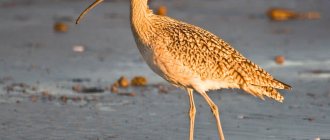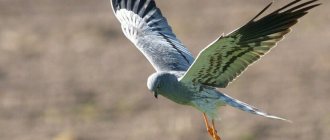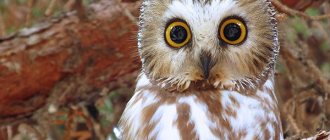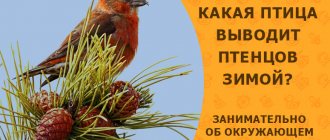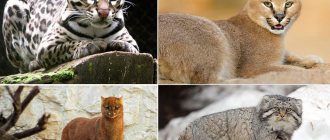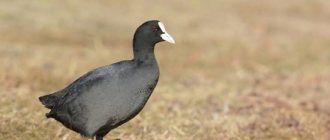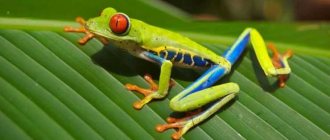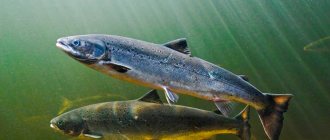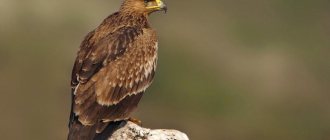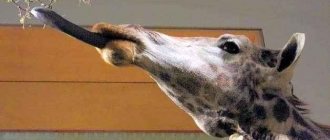Description of the dolphin
Most dolphins are small, no longer than 3 meters, and have spindle-shaped bodies, beak-like snouts (rostrum) and simple, needle-like teeth. Some of these cetaceans are sometimes called porpoises, but scientists prefer to use this term as a common name for six species in the family Phocoenidae that differ from dolphins in that they have blunt snouts and scapular teeth.
Representatives of the raccoon family
Subfamily Procyoninae
This subfamily includes 7 species of raccoons proper (genus Procyon), 3 species of raccoons in 2 genera (Nasua and Nasuella) and 2 species of raccoons (genus Bassariscus). Let's get to know them better.
Raccoons
Raccoons have learned not only to survive, but also to thrive near humans. In their homeland in North America, these cute little animals plunder trash cans, raid homesteads, and even sneak in and out of houses at will. Most townspeople chase away uninvited guests not only because they want to avoid noise and disorder, but also because they are afraid that raccoons will infect their pets with rabies.
Some people take young animals into their homes as pets, but as they age, the behavior of raccoons changes dramatically under the influence of hormones, so even the most persistent owners often prefer to part with them.
The raccoon has a dense build, the weight of adults is 5-8 kg. The animal is easily recognized by its sharp muzzle, similar to a fox, a black mask passing through the eyes, and a long striped tail.
Dolphin species
River dolphins
Amazon Inia (Inia geoffrensis)
The average length of Amazon River dolphins is about 2 m. They come in all shades of pink: from dull gray-pink to rosy pink and hot flamingo pink. This color change is due to the purity of the water in which the dolphin lives. The darker the water, the brighter the animal. The sun's rays cause them to lose their pink pigmentation. The murky waters of the Amazon are protected by the bright hue of the dolphin.
When excited, these animals change their body color to bright pink. There are several anatomical differences between Amazon river dolphins and other types of dolphins. For example, Indians turn their necks from side to side, while most species of dolphins do not have this ability. This trait, combined with their ability to paddle forward with one fin while paddling backward with the other, helps dolphins maneuver against the river's current. These dolphins actually swim on flooded land, and their flexibility helps them navigate around trees. An additional characteristic that distinguishes the Indian from other species is its teeth, similar to molars. With their help, they chew rough vegetation. The bristle-like hairs at the ends of their snouts help them search for food on muddy river bottoms.
Gangetica (Platanista gangetica)
This dun dolphin has an unusual looking head and snout. Their tiny eyes resemble pinprick-sized holes just above the end of their upturned mouth line. Eyes are practically useless, these dolphins are almost blind and detect only the color and intensity of light.
The long, thin snout is lined with many sharp, pointed teeth that elongate towards the tip and are visible on the outside of the mouth. The dorsal fin has the appearance of a small triangular hump, the belly is rounded, which gives dolphins a stocky appearance. The flippers are triangular, large and wide, with a serrated rear edge. The tail ends are also large and wide.
Dolphins grow up to 2.5 m and weigh more than 90 kg, females are slightly larger than males.
La Plata dolphin (Pontoporia blainvillei)
Typically found in coastal areas of southeastern South America. This member of the river dolphin family is the only species that also lives in the marine environment. The La Plata dolphin can be seen in estuaries and shallow coastal waters where there is salt water.
The dolphin has the longest beak relative to body size of any member of the dolphin family. In adults, the beak can make up up to 15% of the body length. They are one of the smallest dolphins, with adults measuring 1.5 m in length.
La Plata dolphins row in the water not with pectoral fins, but with long flippers. Female La Plata dolphins reach sexual maturity at the age of four and, after a gestation period of 10-11 months, give birth for the first time at the age of five. They weigh up to 50 kg (males and females) and live in the wild for an average of 20 years.
Sea dolphins
Common long-billed (Delphinus capensis)
After full maturity, a dolphin reaches a length of up to 2.6 m and weighs up to 230 kg, with males being heavier and longer than females. These dolphins have a dark back, white belly and yellow, gold or grayish sides that follow the shape of an hourglass.
The long, sharp, triangular dorsal fin is located approximately in the middle of the back, and the long beak (as the name suggests) is equipped with small, sharp teeth.
Common dolphin (Delphinus delphis)
He has an interesting color. The body has dark gray patterns that cover it in a V-shape under the dorsal fin on both sides of the body. The sides are brown or yellow in the front and gray in the back. The dolphin's back is black or brown, and its belly is whitish.
Males are longer and therefore heavier than females. They weigh up to 200 kg and up to 2.4 m in length. The mouth has up to 65 teeth in each half of the jaw, making it the most toothed mammal.
White-bellied dolphin (Cephalorhynchus eutropia)
The length of this small species of dolphins averages 1.5-1.8 m in adults. Due to their small size and round shape, these dolphins are sometimes confused with porpoises.
The body color is a mixture of various shades of dark gray with whitish coloring around the fins and belly.
Facilitates identification and distinguishes dolphins from other species: distinctly short beak, rounded flippers and rounded dorsal fin.
Long-snouted dolphin (Stenella longirostris)
Dolphins are known to be skilled acrobats among their kin (other dolphins sometimes spin in the air, but only a couple of turns). The spiny dolphin, native to the eastern tropical Pacific, spins its body seven times in one leap, begins spinning while still in the water just before rising above the surface, and leaps up to 3 m into the air, spinning continuously before falling back into the water. sea.
All long-snouted dolphins have a long, thin beak, a slender body, small curved fins with pointed tips, and a tall, triangular dorsal fin.
White-faced dolphin (Lagenorhynchus albirostris)
The medium-sized dolphin is endemic to the northeast and western Atlantic, has a stocky build with an average length of 2-3 m and weighs up to 360 kg when fully mature.
As the name suggests, the dolphin gets its name from its short, creamy white beak. Its upper part is black. The dolphin has black fins and black flippers. The underparts are white and cream. A white stripe runs above the eyes near the fins to the back and around the back of the dorsal fin.
Common-toothed dolphin (Steno bredanensis)
The species looks unusual; outwardly, dolphins are quite primitive, a bit like prehistoric dolphins. A distinctive feature is a small head. It is the only long-beaked dolphin without a noticeable crease between the beak and forehead. The beak is long, white, smoothly blending into the sloping forehead. The body is black to dark gray. The back is light gray. White belly sometimes with a hint of pink. The body is dotted with white uneven spots.
The flippers are quite long and large, the dorsal fin is high and slightly “hooked” or curved.
Bottlenose dolphin (Tursiops truncatus)
In the human imagination, most likely, all dolphins are bottlenose dolphins. They are the most recognizable of all species due to films and television shows. As a rule, these are relatively large, thick individuals with a dark gray back and pale belly. They have a short, thick beak and an adorable mouth shape that looks like the dolphins are smiling—an unfortunate feature when you think about how attractive that “smile” has made dolphins to the “entertainment” industry. The cuts and markings on the dorsal fin are as unique as a human fingerprint.
Broad-faced (Peponocephala electra)
The torpedo-shaped body and conical head are ideal for fast swimming. There is no beak, the head is softly rounded and decorated with white markings on the lips and dark “masks” around the eyes - especially attractive features of these animals. They have arched dorsal fins, pointed flippers and wide tail fins, steel-colored bodies with dark “capes” under the dorsal fins and pale spots on their bellies.
Chinese (Sousa chinensis)
All humpback dolphins have a small, triangular fin on their “hump.” All humpback dolphins are similar to each other. But the Chinese species has a less distinctive "hump" than its Atlantic cousins, but more obvious than that of the Indo-Pacific and Australian dolphins.
Head and body length 120-280 cm, weight up to 140 kg. Long narrow jaws filled with teeth, wide tail fins (45 cm), dorsal bone (15 cm high) and pectoral fins (30 cm). By color, dolphins are brown, gray, black on top and pale below. Some specimens may be whitish, mottled or freckled. They are sometimes also called Pink Dolphins.
Irrawaddy (Orcaella brevirostris)
There are no difficulties identifying the dolphin. The Irrawaddy has an instantly recognizable, charismatic, rounded head and beakless snout. The animals are similar to beluga whales, only with a dorsal fin. Their movable lips and folds on their necks give expressiveness to their muzzle; dolphins can move their heads in all directions. They are gray all over the body, but lighter on the belly. The dorsal fin is small, the flippers are long and large, with curved front edges and rounded ends, and the tails are also large.
Cruciform (Lagenorhynchus cruciger)
Nature made a distinctive marking on the sides of the animal in the form of an hourglass. The dolphin's base color is black (the belly is white), with a white stripe running along each side of the body (starting just behind the mouth and all the way to the tail), which tapers below the dorsal fin, creating an hourglass appearance. Dolphins also have quite distinctive fins, which are shaped like a hook on a wide base. The more the fin is bent back, the older the individual.
Killer whale (Orcinus orca)
Killer whales (yes, yes, they belong to the dolphin family) are the largest and one of the most powerful predators in the world. They are immediately recognizable by their characteristic black and white coloring: dark black above and pure white below, a white spot behind each eye and on the sides, and a “hot spot” just behind the dorsal fin. Intelligent and sociable, killer whales make a variety of communicative sounds, and each school sings distinctive notes that its members recognize even from a distance. They use echolocation to communicate and hunt.
River dolphin lifestyle and habitat
During the daytime, river dolphins are active, and when night falls, they go to rest in areas of the reservoir where the flow speed is much lower than in their daytime areas.
Where do river dolphins live ? The habitat of Amazonian river dolphins is the large rivers of South America (Amazon, Orinoco), as well as their tributaries. They are also found in lakes and places near waterfalls (upstream or downstream).
During long droughts, when the water level in reservoirs drops significantly, dolphins live in large rivers, but if there is plenty of water due to the rainy season, they can be found in narrow channels, or in the middle of a flooded forest or plain.
Ghanaian dolphins are common in deep rivers of India (Ganges, Hunli, Brahmaputra), as well as in the rivers of Pakistan, Nepal, and Bangladesh. During daylight hours it dives to a depth of 3 meters, and under the cover of darkness it goes to shallow depths in search of prey.
The habitats of Laplatan dolphins can be rivers and seas. They live near the eastern coast of South America, at the mouth of La Plata. Basically, river dolphins live in pairs or small schools, which consist of no more than a dozen individuals. If food is plentiful, dolphins can create schools several times larger.
Dolphin breeding
Dolphins have genitals located on the lower part of their body. Males have two slits, one hiding the penis and the other hiding the anus. The female has one slit containing the vagina and anus. Two milk slits are located on either side of the female genital slit.
Dolphin copulation occurs belly to belly; the act is short, but can be repeated several times in a short time. The gestation period varies by species, with baby dolphins having a period of about 11–12 months and orcas about 17. Dolphins typically give birth to a single calf, which, unlike most other mammals, is generally born tail first. Dolphins become sexually active at a young age, even before reaching sexual maturity, which varies by species and sex.
Reproduction and lifespan of the river dolphin
River dolphins sexual maturity at approximately 5 years of age. Pregnancy lasts for 11 months. After the baby is born, the female immediately pushes him out of the water so that he takes his first breath.
The body length of the cub is 75-85 cm, weight is about 7 kg, the body is colored light gray. Soon after the birth of the offspring, the males return to the rivers, and the females and their offspring remain in place (in channels or valleys that were flooded after the water level rose).
Pictured is a baby river dolphin
By giving preference to such places, females protect their offspring from lack of food, predators, and also from aggressive actions on the part of strange males. The offspring stays close to the mother until about 3 years of age.
There are often cases when a female, without completing the lactation process, becomes pregnant again. The interval between matings can be from 5 to 25 months. River dolphins live no more than 16 - 24 years.
What do dolphins eat?
Fish and squid are the main food, but killer whales feed on other marine mammals and sometimes prey on whales that are larger than themselves.
Herd feeding method: dolphins herd a school of fish into a small volume. The dolphins then take turns feeding on the stunned fish. Trawling method: dolphins drive fish into shallow water to make it easier to catch. Some species hit fish with their tails, stun them, and eat them. Others knock fish out of the water and catch prey in the air.
River dolphin feeding
They feed on fish, worms and shellfish (crabs, shrimp, squid). The rivers in which dolphins live are very muddy; the animals use echolocation to find food.
White river dolphins use their snout to catch fish and also use it as a tool to extract shellfish from the bottom of the reservoir. For prey they go to sections of the river with shallow depths.
They prefer to hunt alone or in small groups. Dolphins take the fish with their front teeth, and then move it to the back teeth, which grind the head first and only after the animal swallows it, crush the remaining part. Large prey is torn into pieces, first biting off the head.
Human relationship with dolphins
Dolphins play an important role in human culture. They are mentioned in Greek mythology. Dolphins were important to the Minoans, according to artistic evidence from the ruined palace at Knossos. In Hindu mythology, the dolphin is associated with Ganga, the deity of the Ganges River.
But people not only love these creatures, but also destroy them and cause suffering.
Drift net fishing and gill nets are unintentionally killing dolphins. In some parts of the world, such as Japan and the Faroe Islands, dolphins are traditionally considered food and people hunt them with harpoons.
A bird of the plovers family with a long curved beak
Examples of the use of the word curlew in literature.
In addition to the well-known game: tadaks, curlews, little bustards and others, animals and various animals are found in the steppes: the whitish steppe fox, which has worse fur and is smaller in stature than the forest fox, red fox, called firefox, hares, hare and cuff, which hunters call feather grass, ferrets , stoats, weasels and carbysh.
The shooting of curlews is very different both in their prey and in the dignity of the prey: steppe waders in the spring, migratory, have not yet split into pairs, or at least have not begun to build nests, are quite well-fed, tasty and, most importantly, rare.
I am convinced of the validity of this assumption by the fact that almost always, in the spring, driving around flooded rivers through valleys and swamps, I met there curlews, who screamed in a flying cry or voice, not so drawn-out and single-knee, but having climbed the mountain and moved into the steppe, a mile away or less, now I found steppe waders, which, obviously, had already begun to rule there: they fought near the same places and screamed in a summer style: they sang loudly when they flew upward, and took another trill knee, the sounds of which are thicker and quieter when fell down and sat on the ground.
Afterwards, when the white partridges cry, the black grouse begin to chuff, and the lek, sometimes right next to the hut, begins its muttering, there is no time for the curlew, but then at sunrise, at the most solemn moment, you will certainly pay attention to the new song of the curlew, very cheerful and similar to dance: this dance is as necessary for meeting the sun as the cry of a crane.
Then they stuffed into her mouth: lamb shoulders with garlic sauce, pates with hot gravy, pork cutlets with onion sauce, capons fried in their own juice, more capons, mergansers, fallow deer, fawns, deer, hares, hares, partridges, partridges, pheasants, pheasants, peacocks, peacocks, storks, chicks, snipe, snipe, ortolans, turkeys, turkey hens and poults, wood pigeons and wood pigeons, pork with grape juice, ducks with onion sauce, blackbirds, shepherds, water hens, scoters, crested herons, teals, ducks, bitterns, water runners, hazel grouse, water hens with leeks, repolov, roe deer, lamb shoulders with capers, king beef, veal brisket, boiled chickens and fat capons with blancmange, hazel grouse, chickens, rabbits, baby rabbits, quails, quails, pigeons, baby doves, herons, herons, bustards, bustards, wood larks, guinea fowl, plovers, geese, goslings, bluebirds, wild ducklings, field larks, flamingos, swans, spoonbills, song thrushes, cranes, billowers, curlews, partridges
Source: Maxim Moshkov library
Natural habitats
Each subspecies is characterized by having its own habitat. For example:
- The Cozumel raccoon is an endemic species that lives on a small Caribbean island off the coast of Kintaa Roo. As a rule, the raccoon lives in mangroves, as well as in island forests, with an abundance of moisture, including within beach areas and cultivated lands.
- The Guadalupe raccoon is a species of land animals that prefer to live in the jungles of Guadeloupe. As a rule, such mammals mainly live in swampy areas, but are also found in dry forest areas located near rivers and lakes.
- The aguara or raccoon is a species of raccoon that has chosen to live in the marshy areas and jungles of South and Central America, including countries such as Trinidad and Tobago. It leads a solitary, nocturnal lifestyle and prefers to stay close to streams, rivers and lakes.
- The American raccoon or striped raccoon prefers the territory of North America, including the Isthmus of Panama and the provinces of southern Canada. However, it lives in France and other European countries.
As a rule, the home of raccoons is located near a reservoir, in the hollows of old trees, at a height of about 30 cm from ground level. The fact that a raccoon lives in this hollow is indicated by numerous scratches on the tree, as well as particles of fur. Raccoons may have several “apartments,” but this animal spends the night in its main “apartment.”
If a raccoon does not find a suitable hollow, it can easily settle in crevices between stone boulders or among the trunks of fallen trees, as well as among piles of branches or brushwood. Although raccoons do not dig holes for themselves underground, they can easily settle in a hole of suitable size left by another animal. These animals easily adapt to new conditions, so they can settle near human habitation, near a populated area, in a park area, etc. As a rule, a raccoon does not leave its territory further than one and a half kilometers.
